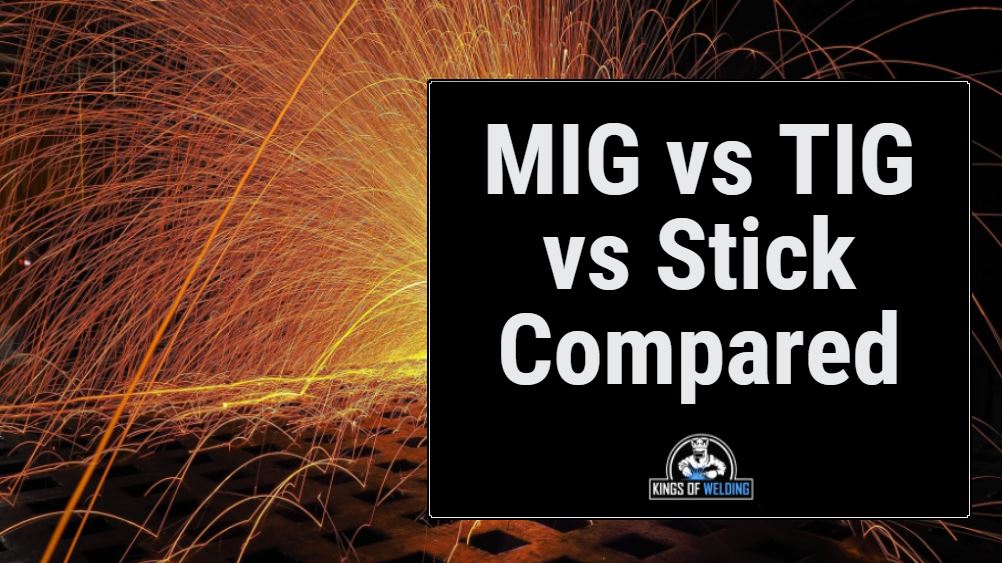There are a number of different types of welding. The most popular are MIG, TIG and Stick welding. Each one of these processes has their own benefits and limitations, you just need to find out which one is best suited for the job in hand.
Generally speaking, TIG is more suitable for clean, intricate welds where appearance is paramount ahead of efficiency. MIG is a much easier process but the results aren’t quite to the same standard as TIG. Stick is useful for welding rusty metal or welding outside on the farm.
There’s no “best process” in welding, you have to choose what’s right for you. The chart below outlines the main advantages and disadvantages of the different types of welding.
| Stick | MIG | FCAW | TIG | |
|---|---|---|---|---|
| Metal Type | Steel, Stainless | Steel, Stainless, Aluminium | Steel, Stainless | All |
| Metal Thickness | 1/8" and above | 24 Gauge and above | 1/8" and above | 22 Gauge and above |
| Skill Level | Medium | Low | Low | High |
| Welding Speed | Slow | Fast | Fast | Slowest |
| Weld Quality | Low | Medium | Low | High |
| Gas Tank | No | Yes | No | Yes |
| Equipment Cost | Low | Medium | Low | High |
Contents
MIG Welding
MIG Welding is the easiest welding process for beginners to learn. To MIG weld you will use a MIG gun which will feed a wire electrode out of a MIG welding machine when you press the trigger. This wire electrode will form an arc with the workpiece and be consumed into the weld pool.
MIG welding uses a shielding gas to protect the arc from the atmosphere to stop it becoming contaminated. The gas flows through the MIG gun and surrounds the wire electrode.
Pros of MIG Welding:
- Easy to learn
- Wire is cheaper than flux-cored.
- Good quality welds with little spatter
- Reduced clean up time
Cons of MIG Welding:
- More complicated setup than FCAW
- Not as good quality as TIG welds.
- Steel needs to be clean
- Need to hook up to a gas cylinder
Gasless MIG (FCAW – Flux Core Arc Welding)
You can also use your MIG welder for flux core welding. In this process, you won’t use gas, but instead use flux cored wire which contains a core that will protect the weld pool from contamination. You can also use a designated flux core welder, which you won’t be able to hook up to gas but will be able to feed flux core wire through the gun.
Pros of Flux Core Welding:
- Easy to learn
- Deep penetration
- Easy to setup
- More portable without gas
Cons of Flux Core Welding:
- Wire is more expensive
- Thicker wire makes is less suitable for very thin metal
- Causes spatter that needs to be cleaned
TIG Welding (GTAW Welding)
TIG welding is a more complicated process than MIG welding which takes practice to get right and is more time consuming. The plus side, however, is that it produces even higher quality welds.
In TIG welding you use a torch with a non-consumable tungsten electrode while slowly feeding a filler rod into the weld pool to fuse the metals together. This can be tricky as it requires you to use both hands and a foot pedal to feed the wire, but it produces really precise welds. There are a number of advantages and disadvantages of TIG but the main things to consider are:
Pros of TIG Welding:
- Higher quality welds than MIG
- Reduced clean up time
- Good for precise welds that require attention to detail
Cons of TIG Welding:
- Harder skill to master
- More time consuming than MIG
- Need to hook up to a gas cylinder
Stick Welding
Stick welding or SMAW (Shielded Metal Arc Welding) is one of the more old-school and inexpensive types of welding. It’s used mainly to weld thick cast iron and steel.
In stick welding, a consumable flux coated welding rod/electrode is used and an electric arc is formed between the electrode and the workpiece metals. The flux coating that surrounds the electrode then disintegrates and protects the weld pool from contamination.
It’s fairly simple to learn but can require a bit more skill than MIG welding because the rod burns down so you need to make sure you’re keeping the arc at the right distance from the workpiece.
Pros of Stick Welding
- Can be used outdoors in windy conditions
- Portable – No shielding gas or wire feeder is needed
- Produces strong welds, including on rusty surfaces and steel does not need to be clean.
Cons of Stick Welding
- Produces slag and spatter
- Lower quality weld
- Inefficient as increased cleanup time and changing electrodes reduces productivity.

